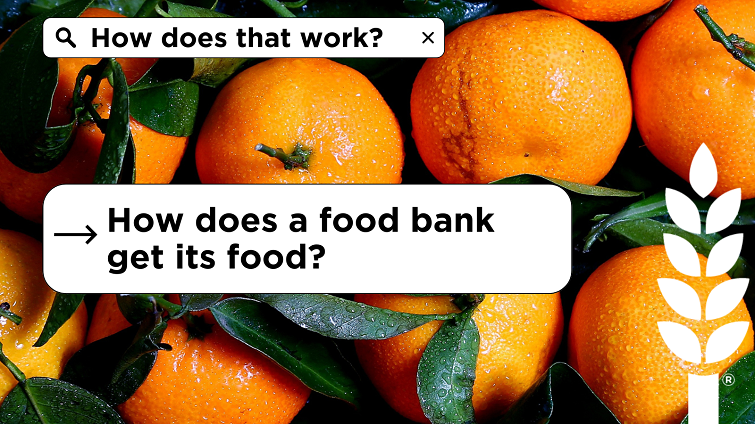SERIES: HOW DOES THAT WORK?
How Does a Food Bank Get Food?
We are launching a new blog series to answer all the burning questions we get when we introduce people to the food bank network. As we walk through programs, facilities, and warehouses, folks will ask “How does that work?” Now we will bring readers closer to the work our food banks do every day. Enjoy!
--------------------------------------
This month we’re diving into procurement—how food banks get food—which turns out to be far more complex than it sounds. We know a food bank is like a warehouse- obtaining and storing food, and then working with organizations and food pantries in the community to get it to the people who need it. But considering the network moved over 400 Million pounds of food last fiscal year, we have to know- how does a food bank get food to begin with?
To help explain this essential process, we reached out to two of our food bank members, Second Harvest of the Big Bend and Feeding Northeast Florida, who shared their insights and experiences with us.
Q: Where does the food come from? Where do the people responsible for feeding entire communities turn when they need to stock their shelves?
Bob Williamson from Second Harvest of the Big Bend: Our food bank brought in a little over 20 million pounds of food last fiscal year. Of that, 24% came from federal programs–The Emergency Food Assistance Program (TEFAP) or The Commodity Supplemental Food Program (CSFP). Then roughly 5% comes from purchases and the rest [71%] are thanks to donations or from farms.
Carrie Russell from Feeding Northeast Florida: We source through a combination of purchases and donations. But within that, a large percentage of our purchases are grant-funded with restrictions to food purchases.
Q: For those donations, do you partner with food manufacturers, grocery chains, or wholesalers? How do those partnerships work?
Bob from Second Harvest: Our retail and manufacturing partners contribute significantly to the food bank. The majority of these relationships have some sort of relationship at the national level with Feeding America. How these partnerships work in practice depends on each donor. We generally book freight to pick up from manufacturers and distribution centers. Retail donations from grocers are picked up by our fleet and by trusted partner agencies.
Q: How do food banks build and support relationships with local farmers, and what role do they play in providing fresh food?
Carrie from Feeding Northeast Florida: We network with local farmers through our partnership with Feeding Florida. We do have distributors who connect us with growers locally as well. Fresh food is a large portion of our distribution model. We support small farmers by purchasing for our growing programs and combining to increase the buying power. I also facilitate purchases for agency partners with these growers.
Q: How do food recovery programs (through gleaning, retail rescue, or similar efforts) contribute to your supply?.
Bob from Second Harvest: We operate a small gleaning program, seasonally. While it doesn’t provide a large amount of donations, it more than makes up for it by engaging our community. It reminds our citizens that they can fight food insecurity not just through financial contributions, but also by volunteering their time.
Carrie from Feeding Northeast Florida: We are heavily focused on retail rescue and increasing agency capacity in the recovery process. It is something we are working on at an agency level to pick up as their capacities are increasing with freight/logistics.
Q: When donations fall short, how do you decide what food to purchase, and where do you buy it from?
Bob from Second Harvest: We’re one of the smaller food banks in Florida and, as such, we don’t have the same resources. There is no purchase budget.
Carrie from Feeding Northeast Florida: As an organization when donations are short, we assess and prioritize the needs of our programs and whether we need to reevaluate those needs. We examine the grant funds available and how those can be applied to fill the shortages we are experiencing. The purchases are analyzed for their impact by program, serving size, and popularity/agency feedback captured.
Q: How do food banks plan for the future? How do they forecast what they’ll need based on what’s expected to be available?
Carrie from Feeding Northeast Florida: We rotate commodities for produce and protein weekly/monthly depending on our buying frequency and available grant funds. I forecast based on programming and we adjust distribution models according to funds available. This creates a very fluid purchasing plan and gives us the ability to pivot quickly as we frequently need to.
Bob from Second Harvest: Feeding America has a number of tools and datasets that help us see what’s happening nationally. We also run reports to see how each donation stream is performing.
In summary, what we learned as we dove into the world of procurement, is that sourcing food for hunger relief efforts is not just about filling shelves, it’s about building flexible, strategic systems that adapt to changing needs and realities.
Whether it’s through recovery programs, partnerships with farmers, or smart forecasting models, Feeding Florida’s food banks are constantly evolving to meet the moment. This is just one aspect of the work they do. Our food banks are navigating complex systems every day to ensure families across our state have access to fresh, healthy food. Stay tuned for more behind-the-scenes looks at the essential work happening across Florida’s hunger relief network.


